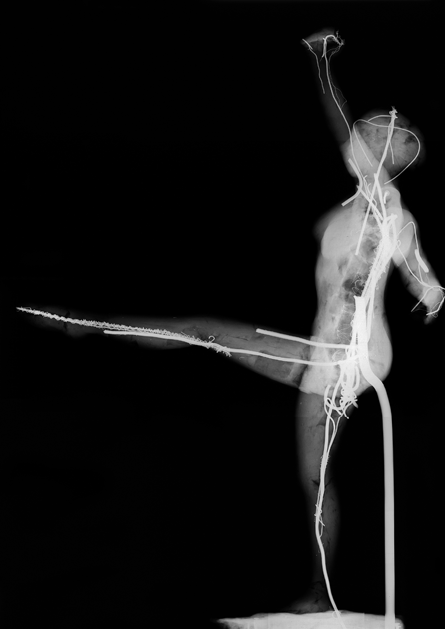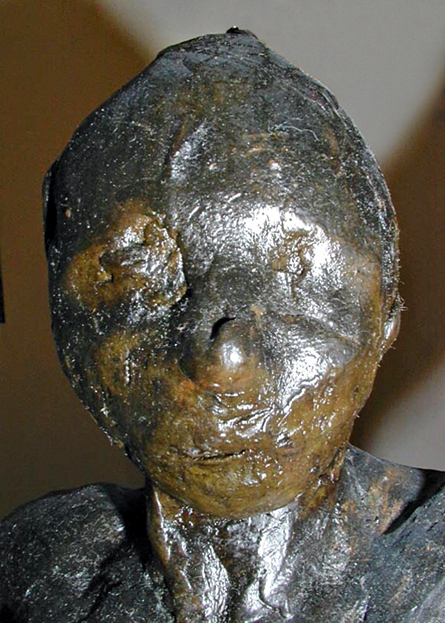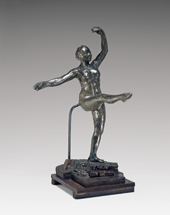The sculpture was made from beeswax with starch having no added fats or resins.[5] The wax was pigmented with lead chromate yellow, barium sulfate, strontium yellow, charcoal black, red iron oxide, terre verte, red lake, and lithopone.[6] The color of the surface varies from olive or yellow-green to darker and discolored areas, most noticeable on the face. The area around the dancer’s eyes, mouth, and chin are yellow-green, while the nose, cheeks, and forehead are dark (fig. 2). This patterning may be due to discoloration or to partial cleaning of previously applied paint and coatings such as shellac.[7] Several of the repaired areas, including the left buttock and thigh, the right hip where the new armature was inserted, and the added wax for impressing the estate cachet, were made with a red wax that was painted dark gray.
The material composition of this work, pigmented beeswax with starch, is significantly different from that of cat. 27, which is composed of plastiline with a wax cladding, and may provide an aid for placing the pieces chronologically. Writing in 1919, Paul-André Lemoisne noted that his friend Degas modeled his pieces by first making one in clay, followed by a plastiline version, and finally one in wax.[8] This observation suggests that Degas made the plastiline and wax-covered version prior to fashioning this wax one at the same scale. The radiographs attest that the piece filled with plastiline required a heavier armature and substantial repairs to the extended leg. The third variant, the diminutive beeswax figure at the Musée d’Orsay, with a lighter internal armature and fewer repairs,[9] is likely the third in the sequence, created once the construction issues had been resolved.
The surface is fairly smooth, while some areas such as the back of the head and the base show evidence of having been modeled with small pellets of wax. A comb or toothed tool was “raked” across the top of the base on either side of the left foot, leaving long vertical striations that slightly mimic the grain pattern of the wooden base. Superficial incisions, cut lines, are present, bisecting the figure’s head, torso, and appendages. In repaired areas, they are interrupted.
Only the upper layer of the wooden base appears to be original. A metal plate projecting from underneath the wax base and screwed into the top of the wood was used to secure the armature wires in place. Longitudinal and cross-sectional slices of cork were placed directly atop the metal plate and wood surface, and then covered in wax pellets to shape the base.
Provenance
The artist, Paris; his five heirs; (Adrien Aurélien Hébrard, Paris); his widow, Mme Adrien Aurélien Hébrard, and/or his daughter, Nelly Hébrard, Paris; consigned 1955, with most of the other lifetime works, to (M. Knoedler and Company, Inc., New York); sold May 25, 1956, to Paul Mellon, Upperville, Virginia.
Exhibited
�Edgar Degas, 1834 – 1917: Original Wax Sculptures, M. Knoedler and Company, Inc., New York, 1955, cat. 42 (exh. cat. Knoedler 1955). Sculpture by Degas, Virginia Museum of Fine Arts, Richmond, 1956 (no exh. cat.). Art for the Nation: Gifts in Honor of the Fiftieth Anniversary of the National Gallery of Art, National Gallery of Art, 1991 (exh. cat. Luchs 1991, unnumbered). An Enduring Legacy: Masterpieces from the Collection of Mr. and Mrs. Paul Mellon, National Gallery of Art, 1999 – 2000 (no exh. cat.).


